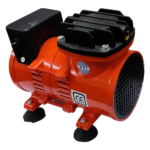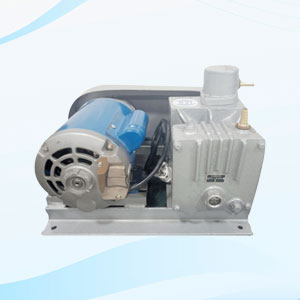Rotary Vane Vacuum Pump
This model is rotary sliding vane type, having four special steel vanes. It is recommended for handling dry and clean air. It is designed as a compact unit with built in inlet air filter and oil baffle cum silencer. A vacuum feed lubrication system positively supplies sufficient quantity of oil to all working parts. The oil mixed with the exhaust air is baffled, separated and is returned back to the oil chamber by pressure of the air, thus reducing the oil consumption to minimum and also avoiding pollution of atmosphere with oil vapour to some extent.
Specifications:
- Displacement:150 Lit / Min 1440 RPM
- Maximum Vacuum:28″Hg
- Operating Vacuum Range:2″ Hg to 28″Hg
- Standard Speed:1440RPM
- Speed Range:1200 to 1750 RPM
- Working Temp:85°C
- H.P.Required:½ H.P.at 1440 RPM
- Rating:Continuous
Application for use as Vacuum Pump:
- Laboratories
- Pollution control equipments
- Material handling equipments
- Labeling machines
- Disordering station
- Glass forming
- Medical instruments Dentists
- Chemical analysers
- Gas charging in A/c
- Suction machines
- Photographic developing machines
A rotary vane vacuum pump is a type of positive displacement pump used to create a vacuum within a closed system. It operates by using a rotating mechanism with vanes or blades that move within a cylindrical chamber. Here’s how a rotary vane vacuum pump generally works:
Rotating Mechanism: The pump consists of a rotor with multiple vanes or blades that are mounted eccentrically within a cylindrical casing. The rotor is driven by an external motor, causing it to spin.
Vane Movement: As the rotor rotates, the vanes slide in and out of slots in the rotor due to centrifugal force. The vanes maintain contact with the inner surface of the cylindrical casing, creating chambers of varying volume between the vanes and the casing.
Vacuum Creation: As the rotor spins, the expanding chambers draw gas or air into the pump through an inlet port. The gas is trapped between the vanes and the casing as the chambers expand. As the chambers contract, the gas is compressed and expelled through an outlet port.
Sealing and Lubrication: Rotary vane vacuum pumps typically rely on a lubricating fluid, often oil, to lubricate the moving parts and create a seal between the vanes and the casing. This lubrication prevents friction and wear on the components while also helping to maintain the seal and vacuum performance.
Maintenance: Maintenance of rotary vane vacuum pumps typically involves periodic checks and replacements of lubricating oil, inspection of vanes for wear, and cleaning of components to ensure optimal performance and longevity.
Advantages: Rotary vane vacuum pumps offer several advantages, including their ability to generate relatively high vacuum levels, their compact size and relatively simple design, and their suitability for continuous operation.
Limitations: However, rotary vane vacuum pumps may not be suitable for applications where oil contamination of the vacuum environment is a concern, as they rely on lubricating oil. In such cases, alternative vacuum pump technologies, such as dry pumps or oil-free pumps, may be preferred.
Overall, rotary vane vacuum pumps are widely used for their reliability, efficiency, and versatility in creating vacuum in various industrial and scientific processes.


